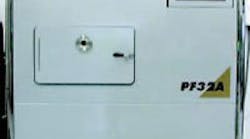Said to be the world's first electron-beam machine (EBM), the PF32A from Sodick Co. Ltd., Schaumburg, Ill., applies mirror finishes in a short time to part surfaces, especially those on molds and dies. It does so using a uniform 2.362-in.-wide electron beam administered in special-exposure conditions and at short repeating bursts, called shots.
The process occurs inside the machine's vacuum chamber where magnetic coils excite the electrons in a supplied argon gas to the point of ionization. When enough atoms ionize, the gas becomes plasma. The machine generates an electron flow by applying a short pulse with a high-voltage cathode and delivers it into the plasma to create an electron beam with high current density.
Electron-beam finishing is safe on part-form accuracies, shortens conventional polishing processes, reaches vertical walls, and leaves an amorphous surface that repels water.
During operation, workpieces rest in the center of the machine's X-Y table. A vacuum is drawn in the chamber, taking about 7 min, and then the machine applies the beam in multiple shots, depending on workpiece material and required surface finish. After processing, the machine refills the chamber with air, and operators unload parts.
The beam processes to a depth of about 0.393 in. and applies to several surfaces, including machined, ground, EDMed, and stamped. On an EDMed part surface, for example, the electron beam improves the finish from a 5 to a 1 Rmax. It is such a new process that Sodick has yet to fully explore its limits. However, all the materials tested so far have worked, including carbide.
Electron-beam finishing is safe on part-form accuracies and shortens conventional polishing processes. It reaches vertical walls, leaves an amorphous surface that repels water to extend die life, improves the release of molding products from plastic dies, and reduces press-die friction.
The amorphous finish results from the electron beam instantly heating the workpiece surface, which then quickly cools. The grains of such surfaces have no crystalline structure, giving them their water-repelling and rustresisting qualities.
There are two versions of Sodick's EBM. One is a basic model with a fixed table (operators manually move the table), and the other sports a programmable X-Y-moving table.





